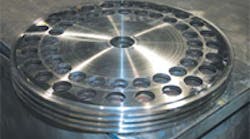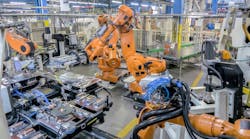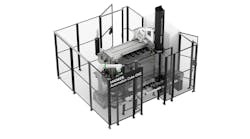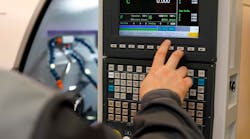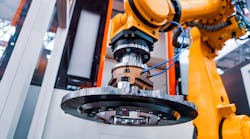After installing a waterjet cutting system with a shuttle table, Johnson Enterprises of New Brunswick, Canada, reaped what some may consider the benefits of “pioneer status.”
The shop, a supplier of debarking tools for the wood, pulp and paper industries, was one of a small handful of companies to own a waterjet in Canada’s Atlantic Provinces, and it was the first shop in North America to automate such a system by adding a shuttle table.
“Our Byjet waterjet system from Bystronic Inc. (www.bystronicusa.com) put us on the map,” Andre Rivard, director of marketing at Johnson, said.
“It enabled us to penetrate new markets as well as introduce ourselves to companies that had never heard of us before. People would travel to our facility just to see our system in action,” he added.
According to Bystronic, the Byjet is the only waterjet on the market with an available shuttle table and swingarm loader for increasing productivity. Also, the company said the system’s rotary axis makes the machine applicable to operations such as tube cutting. Its high-precision head increases cutting precision by optimizing abrasive flow.
While Rivard admitted that Johnson’s surge in new business was partly because of the novelty of the technology, he said most of the new business stemmed from the shop’s newfound processing flexibility.
“We are serving entirely new customers. Orders come in from ambulance and ATV manufacturers and specialized machine shops that work with difficult-to-process materials,” he said.
In addition to generating an expanded customer base and fan club of curiosity seekers and technophiles alike, the waterjet has helped Johnson reduce costs and increase its per part profitability.
The system’s engineered self-sufficiency – by way of minimal tank and pump maintenance, dynamic nesting, shuttle table for parts and materials, and an automated conveyor for garnet removal – minimizes human intervention. The shop also liked Bystronic’s focus on production safety, which means that the waterjet processes parts safely and accurately without an operator.
“Our sheet utilization is 60 percent higher than what we achieved before installing the Byjet. Not only are we equipped to dynamically nest parts, we are able to process more parts out of one sheet of material,” Joey Johnson, the shop’s operations manager, said.
The Byjet maintains tight tolerances, so shops can use common line cutting to process parts faster and with less wasted material. This ability saved Johnson substantial time and money in processing its debarker tips.
Previously, the shop would machine four sides for each tip. Now, it nests parts to achieve one-pass cutting of two parts simultaneously.
According to Johnson, the shop gets as many as 1,300 parts per sheet on the waterjet, as opposed to the 800 pieces it got out of one sheet using a CNC cutting machine. He said the increase has reduced per part cost by 30 percent.
Also, overall part throughput has nearly doubled at the shop, and Johnson attributes that largely to the elimination – or dramatic reduction – of the secondary processes that were previously necessary.
Johnson said the waterjet has effectively deleted four to five manufacturing steps in the production of the shop’s patent pending, spiked debarker.
Another benefit of waterjet cutting is that it does not produce heataffected zones on workpieces.
Due to the E-factor generated by CNC thermal process cutting torches, Johnson’s debarker spikes that were made of a steel alloy often would twist and crystallize. So after every part was cut, it would have to be machined or press straightened, refinished and annealed.
The waterjet system has generated average time savings of 15 min per unit, a considerable time savings on runs of 3,000 parts.
Johnson also noted that, previously, five or six people had to touch each part to complete it, but now only the waterjet operator does.
The Byjet system also has dramatically reduced the workload of the shop’s other cutting systems and the routine wear and tear in processing thick materials.
Johnson’s CNC machines typically were booked three weeks in advance, creating a giant bottleneck in processing challenging orders or in dealing with pressing lead times.
“Often, a cutting torch would take six or seven hours to process one part. The Byjet does one in just over three hours,” Johnson said.
Additionally, the shop anticipates running the system around the clock, which is the reason that it purchased the shuttle table.
“The table option is the most effective way to increase productivity. While we switch materials or remove finished parts, the machine continues to cut,” Johnson added.
A further benefit of the waterjet system has been a reduction in replacement tooling costs at Johnson. The system’s ability to cut parts with tighter tolerances made it a lot easier on the shop’s CNC carbide cutting tools, simply because they had less material to cut. In a typical week, the shop could burn through between $5,000 and $6,000 in tooling.
Johnson said that cost has dropped by $1,500 per week, and that savings does not include the time savings in manufacturing. The tooling and time savings have just about paid for the waterjet machine, he added.
